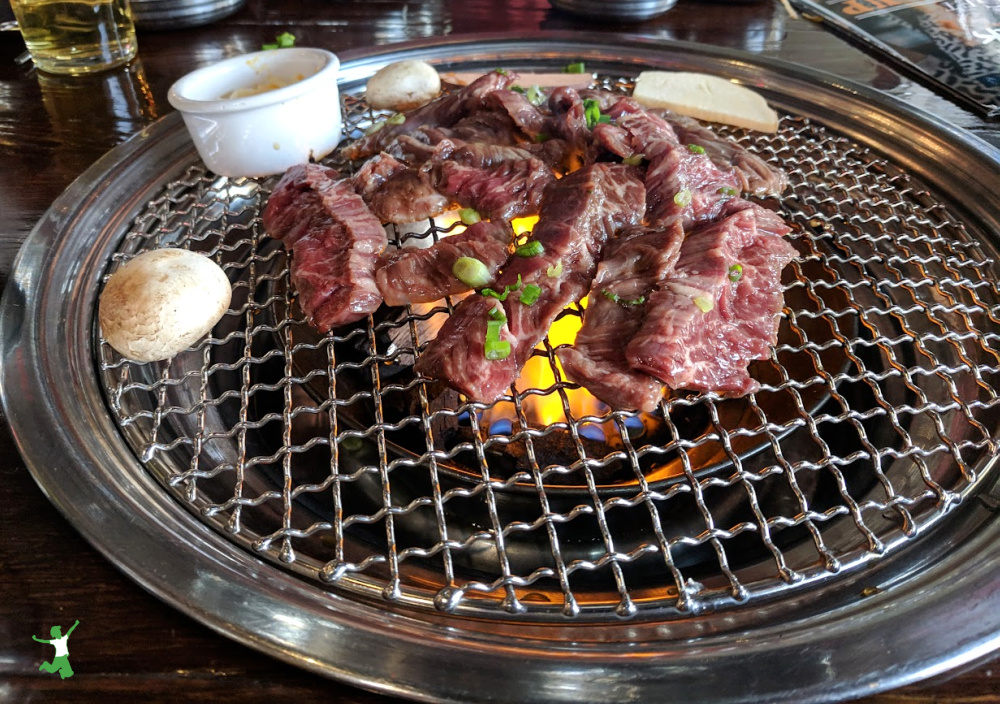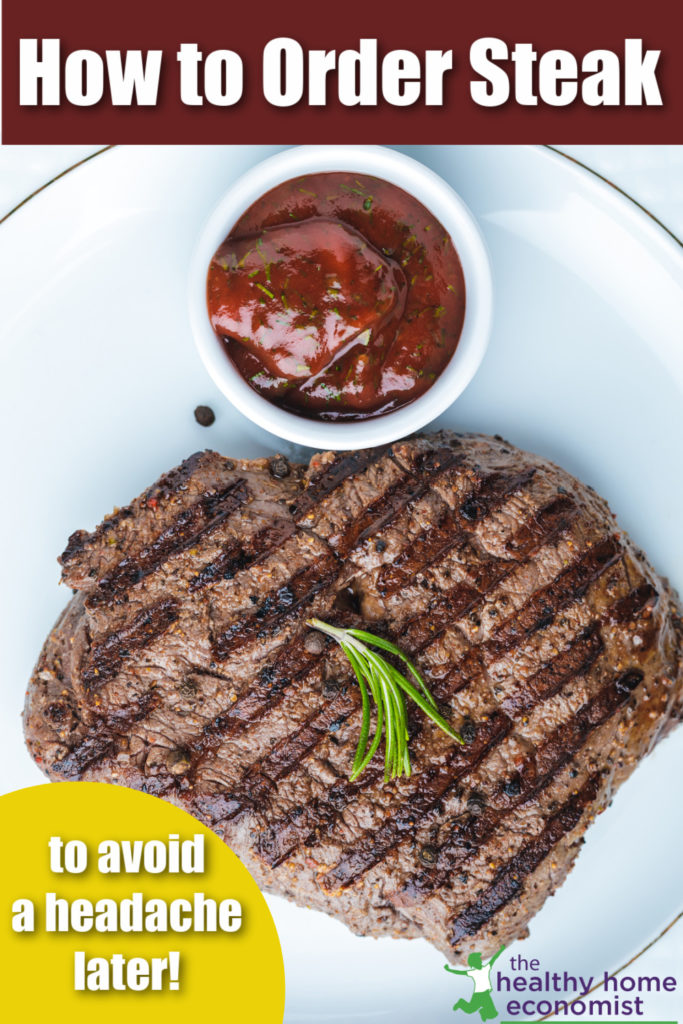Table of Contents[Hide][Show]
How to order steak at a restaurant to ensure an enjoyable experience that won’t leave you with a headache, indigestion, or worse the next day.

I went out to eat at a local steakhouse recently with my extended family for a celebratory dinner. We had a lovely time – good conversation, lots of laughing, and enjoyment of each other’s company.
Unfortunately, the next day I felt pretty rotten for the experience.
While I had made every effort to order food that wouldn’t make me feel lousy or fatigued later, my attempts to dodge the chain restaurant food land mines had failed.
I even had to use my go-to natural headache remedies or I would have had to resort to painkillers to get through the day.
I knew exactly what had gone wrong, and I silently chided myself for wimping out and not saying something to the waiter at the time when the steak I ordered did not arrive as I had carefully instructed.
You know how it goes, though. Sending back your food because it is not served as specified is such an annoyance. At the time, I was having such a good time with my family that I decided to just suck it up and eat the food even though I knew it was going to do a number on me the next day.
This is truly one of the biggest downsides of eating clean, whole foods the vast majority of the time.
When you do eat something that is overly processed or laden with toxic additives, it tends to sucker punch the life out of you for about 24-48 hours afterward.
The optimal digestion and improved health and vitality experienced by eating a traditional diet on a daily basis make the occasional negative event of eating factory foods very, very noticeable.
Those who eat processed foods most of the time don’t seem to suffer from this reality possibly because their bodies are so “used to” getting beaten up by chemicals, additives, and GMOs all the time that their nervous system has stopped even registering the experience.
Does this mean that eating processed foods and apparently not suffering from them is not dangerous?
Definitely not!
I compare the experience to that of an alcoholic who can drink a bottle of whiskey and still appear sober.
Just because the alcoholic can “handle” the whiskey doesn’t mean it isn’t doing tremendous biological damage.
On the positive side, my dinner at Outback Steakhouse provided some good material for this article, so here are the pointers I would suggest next time you go to a restaurant and are trying to order steak in such a way that won’t give you a headache or worse in the coming hours and days.
Skip the Chain Restaurants
The first suggestion I would make if you are going out for steak is to avoid chain restaurants if at all possible.
Chains are cheaper than a locally owned steakhouse and that is why they are popular. That budget-friendly menu comes with a price, however, and that is lower-quality food.
Big companies have significant buying power within the industrialized food distribution system because they buy in huge quantities which allows for big price breaks. This is then passed along to the consumer.
However, food that comes in huge quantities is typically lower quality and processed in a highly industrialized setting.
It would be better to choose a restaurant that only has one or two locations where the owner lives within the same community and is also eating there!
A small restaurant tends to more carefully source its ingredients. For example, at least one steak restaurant in Tampa sources its beef locally from grassfed farms.
Not only would steak from this restaurant taste better than one from a corporate chain, but it would also contain more nutrition too.
Tell the Waiter “No Seasonings”
Another problem with ordering steak out is that when the meat sourced is of low quality, it correspondingly has little to no flavor.
Restaurants, particularly chains or franchises, typically compensate for flavorless meat by brushing steaks with seasonings before grilling.
This makes them taste more like the natural, mouthwatering flavor of grassfed steaks.
The problem with these “seasonings” is that they contain neurotoxic MSG, which will likely give you a headache, nausea, or worse for up to 48 hours afterward.
This is what happened to me at Outback Steakhouse. I ordered my steak without the seasonings (grill only) and yet when the steak arrived and I took a bite, I realized the mistake.
Weirdly, my nose often itches slightly when a bite of food with MSG in it comes near my mouth.
If this happens to you, be sure to send it back and request what you originally ordered. You will be happy you did in the morning.
Order Sauces on the Side
Sometimes steaks are served with some sort of sauce brushed on top. Again, this is typically to enhance the taste of low-quality, flavorless beef.
These sauces usually contain GMO corn syrup, GMO corn starch (thickener), chemicals, additives, and MSG.
It is a good idea to request any sauces (brown sauces, gravy, etc) that come with the steak be served on the side. Then, you can take a small taste first to see if it is made from scratch and might be safe to eat.
Most likely, it will be from a bottle, jug, or packet and not worth consuming.
In that case, just get some butter and garlic on the side to melt over your steak when it arrives, use some salt and pepper and you will be good to go.
Rare or Well Done?
While it is true that a rare steak is easier to digest and more nutritious than a steak with the life cooked out of it, if you are eating steak at a restaurant where the quality of the steak may be questionable, I would suggest ordering it well done. This will avoid the potential for pathogens or parasites in the meat.
If you are ordering steak at a quality restaurant in your community that sources from local, grassfed farms, however, ordering the steak seared or rare to medium would be fine and certainly a more enjoyable and digestive-friendly experience.
Do you have other tips to order steak safely at a restaurant? Please share your experience or knowledge with us in the comments section.
If you’d rather just prepare steak at home instead of ordering out, here is an MSG-free, homemade steak sauce recipe to try!








I recently had to eat at an Outback and decided that the New Zealand lamb chops were probably the best choice. I’ve heard that lambs are typically grass fed, but I could have been thinking of goats.
Not sure if you can do this!
We learned this quickly too. Thanks for passing along to others
Meat surfaces have the issues with bacteria and parasites. Ground meats have myriads of surfaces mixed all through it, and heat kills these- therefore, ground meats must be well done. The foods with the greatest chance of carrying toxoplasmosis parasites in the U.S. include raw ground beef or rare lamb; unpasteurized goat’s milk; locally produced cured, dried or smoked meat; and raw oysters, clams or mussels. Roasts and steaks get cooked on the surfaces, so rare and medium rare are just as safe as well done for beef. Lamb and pork should be cooked thoroughly.
– See more at: https://www.thehealthyhomeeconomist.com/order-steak-restaurant-get-sick-later/#sthash.QzckNvNJ.dpuf
Meat surfaces have the issues with bacteria and parasites. Ground meats have myriads of surfaces mixed all through it, and heat kills these- therefore, ground meats must be well done. The foods with the greatest chance of carrying toxoplasmosis parasites in the U.S. include raw ground beef or rare lamb; unpasteurized goat’s milk; locally produced cured, dried or smoked meat; and raw oysters, clams or mussels. Roasts and steaks get cooked on the surfaces, so rare and medium rare are just as safe as well done for beef. Lamb and pork should be cooked thoroughly.
What Steak restaurant in Tampa? I found FreshBites but it isn’t a steak restaurant.
**See her comment above
It is such a shame, because I used to love eating out so much. I gave up on Outback many years ago for so many reasons, one of them being the icky hidden “seasonings.” Having gut issues, these would make me ill, even back when they were serving something closer to real food. We are lucky living near Seattle to have many independent restaurants that make much from scratch, so if we go out for steak a couple of times a year, we go there. However, I am too exhausted to cook every day, so when we do go out for a quick weeknight meal, we usually stick to an assortment of small, family-run ethnic restaurants in the area, who still cook everything like it’s from their own home kitchen. Not perfect of course, but the food is usually made using a few simple ingredients without weird chemical additives, and I rarely if ever feel sick after eating at them. We love spicy food and have an adventurous palate, so it’s enjoyable for us to eat at these places, it’s usually quite inexpensive, the food is delicious and flavorful, we support small family businesses, and best of all I can relax and not do the cooking sometimes. 🙂
My husband and I figured out that because we eat clean at home, we were getting sick from the toxins when eating out.Sarah just confirmed this with her article. During one foray, we felt fatigued and sickly for 48 hours afterwards, and our dinner bill was $100! So, just know that because a restaurant is expensive, you can’t leave your guard down. Fortunately, my immediate family eats clean, so I don’t have an issue with people not understanding. When we got out, the entire table is driving the wait staff nuts. While we avoid places like the Outback, I do want to add to the “Stay Away List” the restaurant chain Applebees. The problem that someone mentioned is that these types of places have their steaks and other foods delivered to them pre-packaged with the toxic sauces already on them. I really hope Sarah and perhaps with the help of others input, could come up with a game plan to fortify oneself against these toxins. Someone mentioned charcoal before eating. What about chorella? I know there are things to help reduce a hangover after you had too much to drink. What about an msg hangover?
Dr. Blaylock recommends magnesium to help counter neurotoxins (like MSG). The last time I ate out, I was feeling the all-over-body-aches and fuzzy headedness from MSG before I walked in my door. I had a cup of warm water with lemon juice and about 4 mls of Trace Mineral’s Mega Mag (400 mgs of magnesium), applied several sprays of magnesium oil, plus did a hot foot soak with magnesium oil and baking soda to detox as much as possible. I was feeling better by the time I took my feet out of the cool water. 🙂
The last time we went to outback, my husband ordered a hamburger. Would you like it well or medium well done? asked the waitress. My husband said ‘medium rare, please’. The waitress just repeated verbatim what she said the first time. Apparantly they aren’t allowed to serve the burgers less than charred. So, he ordered a kabob instead. We later went to a better steak house, and hubs ordered a hamburger medium rare. No problem said the waiter. We asked about the difference in attitude and he told us ‘we know where our meat comes from. If you get sick we can isolate it. However, at Outback they can’t do that with their ground beef’. We haven’t been back to outback, ever.
Activated charcoal would probably lessen the symptoms by absorbing the toxins in the food.